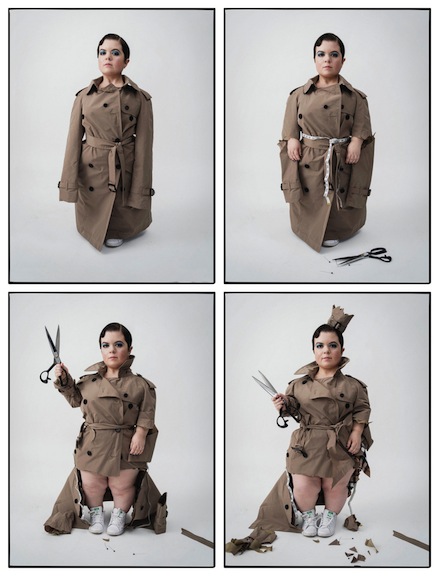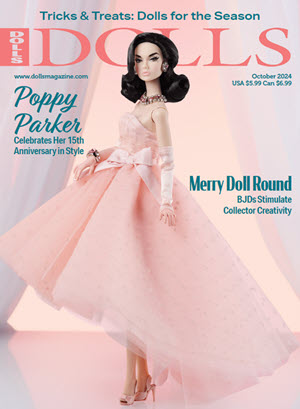As society becomes more inclusive, it is not surprising that the toy box has become more open and welcoming, too. For many years, a certain notion of beauty and aspirational play reigned supreme. Children were encouraged to act out their fantasies with golden-tressed dolls that boasted impossibly curvaceous silhouettes. Indeed, if Barbie actually existed in our world, she would most likely suffer from extreme backaches and balance issues. Still, because she did fit into the Hugh Hefner playbook of cheerleader good looks, Barbie became the standard of attractiveness. This is something that is being redirected and re-examined by parents, children, and toy companies themselves. Lottie Dolls is one such manufacturer, and their Sinéad Burke doll is both a revelation and a cultural advancement.

Burke is a well-known author, academic, and broadcaster. Much of her success is found on the other side of the Atlantic, particularly in Ireland. That nation’s president, Michael D. Higgins, appointed Burke to be a member of Ireland’s Council of State. Intelligent and opinionated, Burke has garnered attention for her efforts in diversity advocacy and was skyrocketed to international acclaim for her TED Talk. Much of her lecturing and activism orbit around the issues of “design and disability.” Breaking down barriers, Burke is a natural selection for Lottie Dolls’ portrait creation. She is determined to make sure that little people are seen and heard. Standing 3 feet 5 inches, Burke is adamant about having her likeness and that of others brought to the forefront.

At age 29, Burke has accomplished much to make her personal challenges and that of her peers known to the public. She is fearless about expressing the needs and desires of her community. The Sinéad Burke doll is one more milestone for a young woman who has been racking up achievements.
“There’s that phrase ‘if you can see it, you can be it.’ As a littler person, I have lived my life in a world that was not designed for me. I grew up in an era where my experience was never reflected in culture, in the books that were in my classroom library,” Burke told the Doll Chronicles. “My truth was not in the dolls that I played with as a child. I’m incredibly honored to volunteer on this project with Lottie Dolls. The potential for this to change how little people see themselves, and how the world views little people, is immeasurable.”

The Sinéad Burke doll will have the same head and torso ratio as all the other Lottie Dolls have. However, this doll’s hands, arms, and legs will be smaller and will have achondroplasia proportions. The Sinéad Burke doll will wear a stunning red gown and red shoes, based on Burke’s own wardrobe. Burke caught photographers’ attention when she wore this ensemble to the Elle 2018 awards.
Meghan Markle, the Duchess of Sussex, also noticed Burke during her royal visit to Ireland. Impressed by the young woman’s passion and style, Markle took note. When she guest-edited the September 2019 British Vogue, she invited Burke to be one of her “Forces for Change.” Previously, Burke had graced the interior of Vogue as a columnist, contributing editor, and one of their handpicked 25 influencers. Under Markle’s direction, Burke went from covering fashion to being on the cover. Photographed in sophisticated black and white, Burke became the first little person to ever appear on the cover of any Vogue magazine.

In an August 2019 open letter, Burke talked about the significance of this moment. “The response I have received has been overwhelmingly supportive, uplifting, and really quite emotional. Parents of little people have sent me photographs of their babies holding the magazine tightly to their chests. Teenagers who look like me have got in touch to ask questions about how they can work in fashion. Disabled people from every corner of the world have appeared in my Instagram DMs,” she wrote. “They are articulating the power of representation and their hopes that greater visibility will extend to all intersections and disabilities.”

Popular culture is a force that does more than just entertain and even educate. It has the ability to open up a floodgate for social change and overall recognition. Once people see something or someone different, and begin to understand and engage, then the possibility of discourse follows.
“There is a privilege, and also a responsibility, that comes with being the first to achieve or accomplish any goal. My hope is that fashion magazines become a haven and an incubator for conversations narrated by and about disabled people,” Burke stated. “Although it has taken until 2019 for such a first to occur, I hope minority voices and bodies will soon populate the covers and pages of glossy magazines everywhere.”
This mission of hope and relationship building is at the crux of the Lottie Dolls and Sinéad Burke partnership. The Sinéad Burke doll is a first step in getting children to feel comfortable with different-bodied people and to interact with them in a positive manner.

“The Sinéad Burke doll is an activist in every sense. The development of this particular doll challenges designers, engineers, buyers, and industry decision makers across the board,” Ian Harkin, managing director of Lottie Dolls, addressed. “We are asking them to consider the entire spectrum of their customers. This doll is reflective of Sinéad’s own advocacy for representation and inclusion. It aims to inspire and reinforce a more accommodating approach to design — as opposed to the ‘one size fits all’ method, which is commonplace in our society.”
Harkin has data to back up his assertions and resolutions. Besides being guided by his own principles and gut reactions, he was influenced by a UNESCO report on bullying. He firmly believes that “visual differences,” such as nationalities, race, and disabilities, are at the core of childhood aggression and conflict.

“We discovered research by psychologist Dr. Sian Jones at Queen Margaret’s University in Edinburgh,” “She studied the effects of playing with toys with differences, on the attitudes of children without difference. Interviewing hundreds of children, she found that after playing with toys like the Sinéad Burke doll, children were more open to forming friendships with peers with difference. To me, that was so powerful. It is remarkable to realize that a toy could be used as a tool to develop empathy and understanding of differences as much as to bring joy. We decided we would make it part of our mission to be more inclusive in our design,” Harkin stressed.

“We’ve long-admired Sinéad and her activism and values, which are closely aligned with our own,” Harkin told the Doll Chronicles. “Through the years, we’ve formed a friendship with her. We were privileged to have Sinéad’s input, insights, design-eye, and keen involvement as we collaborated on this project.” The Sinéad Burke doll was created in partnership with the charity Little People of Ireland. One euro from each Sinéad doll sold on the Lottie website will be donated to the organization. The doll can be pre-ordered, and its U.S. price is $20.






